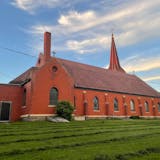In the spring of 1903, 24-year-old Mary Hannah Gibbs faced off with an armed lumberman near the Mississippi River headwaters at Itasca State Park in what became one of Minnesota's first clashes between conservationists and industry.
Lumberjacks had felled countless giant red and white pines that winter, sledding them to Lake Itasca for a massive spring log drive to sawmills stretching 480 miles downriver to Minneapolis. The higher the water level, the higher the profits for loggers floating their product to market, and they wanted the dam kept shut.
In the meantime, Gibbs had become the first woman to run a state park in the United States upon the death of her father, John Puckett Gibbs, Itasca's second park commissioner, when his kidneys failed in February 1903. Seven weeks later, she wrote her boss in St. Paul, Attorney General Wallace B. Douglas:
"The water in the lake is now about 20 inches above high water mark, and it is rising from one to two inches per day … If the gates of the dam are not raised the lake shores will be ruined."
The showdown escalated when a lumberman with a rifle told Mary Gibbs — who reportedly carried a gun herself — and a warrant-waving constable that he'd shoot anyone who put a hand on the sluiceway lever to open the dam.
"I said: 'I will put a hand on there and you will not shoot it off, either.' And I did," Gibbs recalled more than 50 years later, second-guessing her bravado a bit. "I don't think it was a very smart thing for me to do that, as he might just have done what he said."
Gibbs won the battle but lost the war. Her gutsy stand proved mostly symbolic. It took a half-dozen men, led by a local sheriff, to open the dam and drop the water level a foot and a half. Lumbermen soon won injunctions, barring Gibbs from what she called further interference.
Her expected appointment to succeed her father never came. She moved to Minneapolis and then Canada, dying in Vancouver, B.C., in 1983 at the age of 104.



